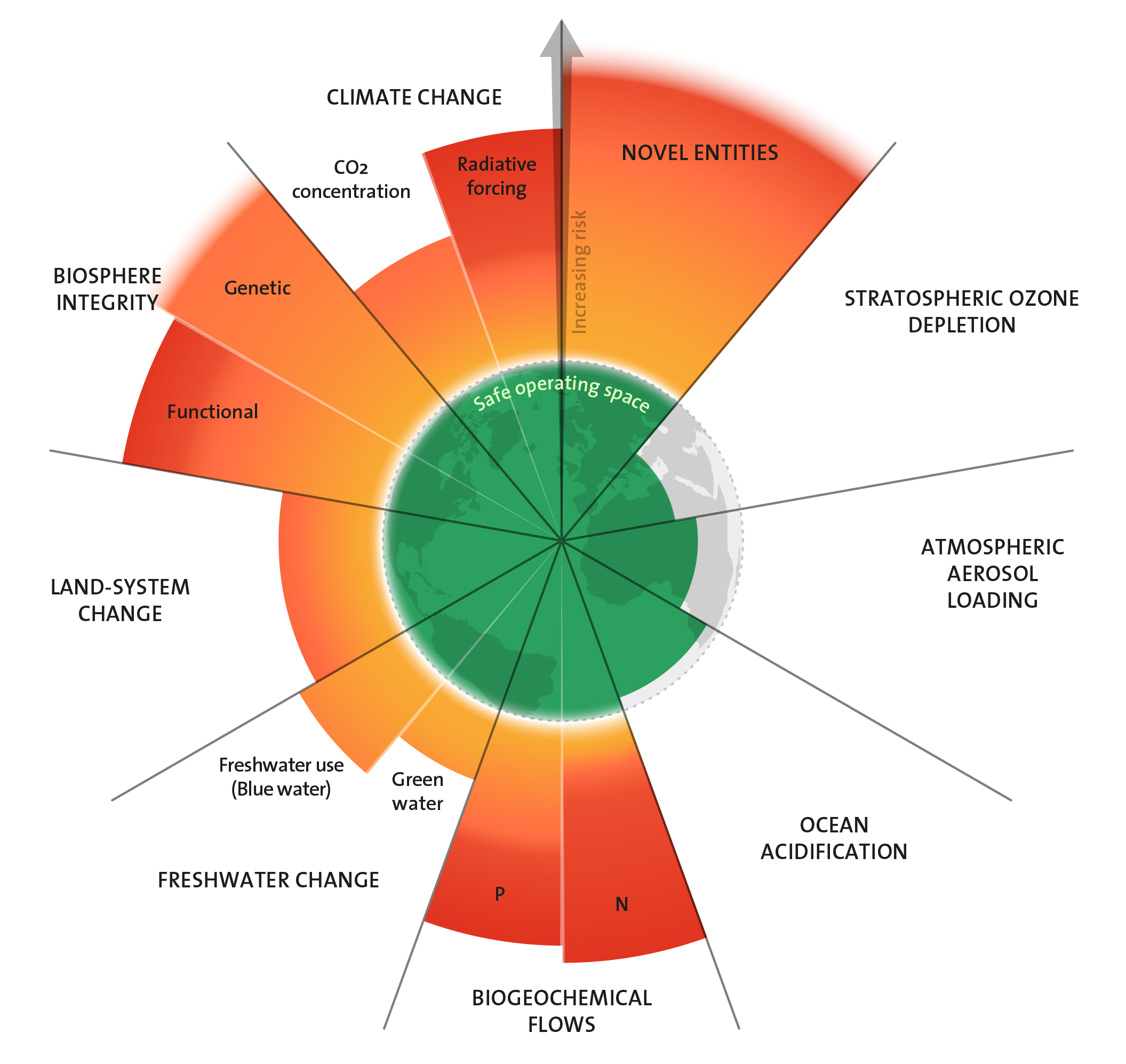Today’s Contemplation: Collapse Cometh CLXXXVI–Collapse = Prolonged Period of Diminishing Returns + Significant Stress Surge(s), Part 2
 Tulum, Mexico (1986). Photo by author.
Tulum, Mexico (1986). Photo by author.
This Contemplation follows from Part 1 (Website; Medium; Substack) that was prompted by the devastation brought to the southeastern United States by way of Hurricane Helene. This recent natural disaster (followed closely by Hurricane Milton) is but one of dozens to hit the globe during the past year.
As I stated in the introductory Contemplation “my own immediate reaction to the significant damage and a few articles/conversations with others has me viewing the tragedy that is unfolding as another step in the path towards ‘collapse’ of the U.S. nation as currently constructed. Another straw, as it were, on the camel’s back that supports societal complexity for this particular nation state/empire–which would have repercussions for most other societies on our planet given U.S. global hegemony (and its faltering nature).”
I view impending societal ‘collapse’ through the thesis proposed by archaeologist Joseph Tainter who basically posits that complex societies become susceptible to socioopolitical collapse/simplification as they encounter diminishing returns on their investments in problem-solving. This is primarily due to a society’s tendency to solve issues via greater complexity requiring more resources (especially energy) that become more difficult to acquire given our proclivity to extract the easiest-to-access reserves first, leaving more difficult-to-access ones for later use. All it then takes is time–with society using increasing amounts of its resource surpluses to maintain complexities–or a sudden stress surge that then overwhelms available resources to experience ‘collapse’.
As Tainter states: ”[c]omplex societies are problem-solving organizations, in which more parts, different kinds of parts, more social differentiation, more inequality, and more kinds of centralization and control emerge as circumstances require.” (p. 37)
Societal ‘collapse’, then, is a reversal of this increasing complexity. Again, as Tainter argues: “Collapse…is a political process. It may, and often does, have consequences in such areas as economics, art, and literature, but it is fundamentally a matter of the sociopolitical sphere. A society has collapsed when it displays a rapid, significant loss of an established level of sociopolitical complexity.”
In Part 1, I describe how complexity and collapse are viewed in Tainter’s thesis. In this Contemplation I look at diminishing returns and begin to explore what the ‘collapse’ process entails, i.e., what occurs during and what follows the loss of sociopolitical complexity.
What are diminishing returns?
While Tainter’s collapse thesis is primarily concerned with the sociopolitical realm, it’s vital to understand that complex societies are dependent upon continuous energy flows. The acquisition and distribution of resources is integrated within sociopolitical institutions. These must evolve in harmony and the energy must be enough to maintain the sociopolitical institutions that serve to organise and maintain society’s numerous complexities. Energy, then, is THE fundamental resource supporting societal complexity (and this explains why access to/control of hydrocarbon reserves motivates so much of human geopolitics; and probably has for a century or more).
Tainter proposes that the return on investment in complexity varies and such variation follows a specific curve; that “in many crucial spheres, continued investment in sociopolitical complexity reaches a point where the benefits for such investment begin to decline, at first gradually, then with accelerated force. Thus, not only must a population allocate greater and greater amounts of resources to maintaining an evolving society, but after a certain point, higher amounts of this investment will yield smaller increments of return. Diminishing returns, it will be shown, are a recurrent aspect of sociopolitical evolution and of investment in complexity.” (p. 92)
As Tainter argues complex societies, as problem-solving organisations, are maintained through control and specialization but “[t]he reasons why investments in complexity yields a declining marginal return are: (a) increasing size of bureaucracies; (b) increasing specialization of bureaucracies; (c) the cumulative nature of organizational solutions; (d) increasing taxation; (e) increasing costs of legitimizing activities; and, (f) increasing cost of internal control and external defense.” (p. 115)
As a society becomes more complex, its costs increase but the benefits of each additional change is not in proportion to the costs, and in some cases there are no benefits at all. Once more complex features are added, they are rarely abandoned so growth in complexity tends to be exponential. By adding greater complexity “the potential for problems, conflicts, and incongruities develops disproportionately.” (p. 116)
There are benefits for many added complexities but they only provide less and less positive return for the cost. Eventually “societies do reach a level where continued investment in complexity yields a declining marginal return. At that point the society is investing in an evolutionary course that is becoming less and less productive, where at increased cost it is able to do little more than maintain the status quo.” (p. 117)
Keep in mind that ‘collapse’ is a process and not an event. As a process, it should be viewed as occurring along a continuum with a somewhat elongated timeline; it does not occur with a specific event (usually, but catastrophic natural disasters may have it happening ‘overnight’; for example, the eruption of Mount Vesuvius and its impact upon Pompeii and surrounding regions of the Roman Empire). And although the recognition from a complex state to a simpler one may be relatively ‘quick’ (say a generation or two), in most cases it seems to take a relatively long time (perhaps a century or more).
This recognition of ‘collapse’ seems more a cognitive one than an actual physical one. Humans being who they are create narratives to view societal collapse in a rather simplistic way to help it make more sense. It’s one of the reasons we suggest that wars begin with specific events (say the assassination of Archduke Franz Ferdinand for World War 1) rather than the result of a build-up of small and seemingly innocuous grievances and geopolitical maneuvers. It’s simpler to associate a singular event (assassination) as being the cause of something (war), rather than attempting to understand the many complexities that accumulate and lead to certain consequences. It also provides leverage/cover to the stories of ‘blame’ and ‘response’ that circulate–especially during wars when ‘rulers’ are attempting to persuade citizens to support their actions/decisions and to rationalise their own atrocities during wars.

A good parable/metaphor for understanding what I am suggesting may be that regarding boiling a frog. This is primarily about a cognitive shift/awareness after a period of small but cumulative changes. Recognising when ‘collapse’ has occurred is perhaps more about human perceptions and the need to identify a discreet moment or event where everything changed. This need is basically a heuristic to help us understand and simplify what is a complex process that likely does not exhibit a precipitous causal event.
Boiling a frog is a metaphor for the problem we all have perceiving changes that are gradual but cumulatively significant, that may creep up and have devastating consequences: a little increase here, a little there, then later some more. Nothing changes very much and things seem normal. Then one day the accumulation of changes cause the appearance of normality to disappear. Suddenly things have changed a great deal. The world is different, and it has been altered in a manner that may not be pleasant.
Joseph Tainter & Tadeusz W. Patzek, 2012
Drilling Down: The Gulf Oil Debacle and Our Energy Dilemma
Certain events and societal tendencies contribute significantly to ‘collapse’ but it appears primarily to be the result of a sudden, unexpected stress surge after a prolonged period of diminishing returns. And while the stress(es) may be the result of particular ‘events’, the ‘collapse’ is typically a process that takes time to unfold–how much time varies. For example, evidence suggests that the ‘collapse’ of Easter Island’s complex society took only a generation or two, while that of the Roman Empire several centuries.
Diminishing returns eventually require that surpluses be consumed to maintain status quo complexities. But at some point in a society’s existence, stressors cannot be adequately addressed–at least not in the eyes of the people who belong to the sociopolitical organisation–and the necessary human support to maintain the various institutions begin to fray and eventually break.
Also remember that ‘collapse’ can be regional, occurring in localised areas; not necessarily consuming the entire complex society in question. For example, the ‘collapse’ of specific regions of Mayan society where the archaeological evidence for the Lowlands Indicates that this particular region was abandoned (viewed as ‘collapse’) while surrounding regions continued uninterrupted or show some growth in complexity (perhaps as a result of Lowlands people migrating into them). This is also true for the Western Roman Empire that ‘collapsed’ long before the eastern provinces.
For Tainter, ‘collapse’ occurs when the sociopolitical system can no longer sustain itself and breaks down as a result of members ‘opting out’. This is primarily an economic decision: if the cost/benefit ratio of providing support for the sociopolitical institutions is too high, citizens will remove their support in various ways. Refusing to participate in activities of expansion or defense, or not paying ‘taxes’ could prove too much to sustain sociopolitical systems in a region. It could also be as simple as migrating out of the area. Ultimately, the complex systems break down and ‘collapse’ ensues.
Unexpected stress surges and ‘collapse’
As Tainter argues, the systems that maintain a functioning society weaken with diminishing returns. A weakening of these systems opens the door to ‘collapse’ due to sudden stress surges.
“Unexpected stress surges must be dealt with out of the current operating budget, often ineffectually, and always to the detriment of the system as a whole. Even if the stress is successfully met, the society is weakened in the process, and made even more vulnerable to the next crisis. Once a society develops the vulnerabilities of declining marginal returns, collapse may merely require sufficient passage of time to render probable the occurrence of an insurmountable calamity.” (p. 121)
In addition, declining marginal returns can lead people to view complexity as a failed problem-solving strategy. As Tainter states: “Where marginal returns decline, the advantages to complexity become ultimately no greater (for the society as a whole) than for less costly social forms. The marginal cost of evolution to a higher level of complexity, or of remaining at the present level, is high compared with the alternative of disintegration.” (p. 121)
For some, then, the option of detaching from larger sociopolitical forms is more attractive since fewer benefits are resulting from the costs they are incurring. As a result, smaller social units begin to pursue their own goals, forsaking those of larger units. The status quo may respond to this shift through greater legitimisation activities and/or control. Peasant revolts may occur or, more commonly, apathy towards well-being of the polity increases.
Sustaining services for a population becomes increasingly difficult as rising marginal costs due to declining resources saps economic strength. Unexpected stresses and normal operations are met by using reserves. Society begins to disintegrate as local entities break away or the ruling government is toppled militarily.
A society increasing its complexity through ever-increasing investment will eventually reach a point when marginal productivity can no longer rise; complexity can still accrue benefits past this point but at a declining marginal rate and stress will begin to rise (e.g. between growth/no-growth factions). Although greater investment is made in research and development and education in an attempt to find solutions, taxes and inflation increase making collapse more likely. A point may be reached when increasing complexity actually results in decreased overall benefits.
A society with inadequate reserves becomes extremely vulnerable at this time since a significant stress surge can overwhelm the various systems required to maintain complexities. The leadership may impose strict behavioural controls in response in an attempt to decrease inefficiencies.
What follows ‘collapse’?
I am convinced by the archaeological evidence–and thus believe–that societal ‘collapse’ as proposed by Tainter for our current iteration of it is inevitable. 12,000 years of pre/history during which time countless numbers of experiments in complex societies have been attempted suggest this. Is it guaranteed? Of course not. No one can predict the future with much if any accuracy but why would our go at it have the ‘Goldilocks’ outcome of being just right. You know the ‘this time is different’ ending, especially given the ecological overshoot predicament we are also trapped within.
On top of the issue of diminishing returns on our investments in complexity we have so exceeded numerous planetary boundaries that the natural environmental carrying capacity of almost all regions of the planet are greatly depressed, making the possibility of societal ‘rebirth’ after the collapse of our global industrial society as close to zero as we might get (if not zero, depending on whose story of the future one subscribes to). Of course, pre/history also shows that some form of society always ‘rises from the ashes’…so there’s that for those holding out ‘hope’.
(See: https://www.stockholmresilience.org/research/planetary-boundaries/the-nine-planetary-boundaries.html)
Keep in mind, however, that the discussion that follows is focused upon the evidence of what has befallen past complex societies. The future of global, industrial societies is likely to rhyme with the past, with its own variations upon the tendencies that arise with sociopolitical collapse of human complex societies, but it will not be exactly like the collapses of the past.
In Part 3, I will expand on what the past tells us about what a complex society looks like post ‘collapse’. As some have argued, it is a ‘simplification’ and/or ‘adaptation’ to circumstances and not the ‘end of the world’. A ‘dark age’ in comparison to what preceded it may occur, but human existence continued. Of course, what this will look like alongside ecological overshoot responses is entirely up in the air.
While awaiting Part 3, ponder our current responses to diminishing returns and growing stressors given previous societal responses. It certainly appears to be rhyming to me…
If you’ve made it to the end of this contemplation and have got something out of my writing, please consider ordering the trilogy of my ‘fictional’ novel series, Olduvai (PDF files; only $9.99 Canadian), via my website or the link below — the ‘profits’ of which help me to keep my internet presence alive and first book available in print (and is available via various online retailers).
Attempting a new payment system as I am contemplating shutting down my site in the future (given the ever-increasing costs to keep it running).
If you are interested in purchasing any of the 3 books individually or the trilogy, please try the link below indicating which book(s) you are purchasing.
Costs (Canadian dollars):
Book 1: $2.99
Book 2: $3.89
Book 3: $3.89
Trilogy: $9.99
Feel free to throw in a ‘tip’ on top of the base cost if you wish; perhaps by paying in U.S. dollars instead of Canadian. Every few cents/dollars helps…
https://paypal.me/olduvaitrilogy?country.x=CA&locale.x=en_US
If you do not hear from me within 48 hours or you are having trouble with the system, please email me: olduvaitrilogy@gmail.com.
You can also find a variety of resources, particularly my summary notes for a handful of texts, especially Catton’s Overshoot and Tainter’s Collapse: see here.
Released September 30, 2024
It Bears Repeating: Best Of…Volume 2
A compilation of writers focused on the nexus of limits to growth, energy, and ecological overshoot.
With a Foreword by Erik Michaels and Afterword by Dr. Guy McPherson, authors include: Dr. Peter A Victor, George Tsakraklides, Charles Hugh Smith, Dr. Tony Povilitis, Jordan Perry, Matt Orsagh, Justin McAffee, Jack Lowe, The Honest Sorcerer, Fast Eddy, Will Falk, Dr. Ugo Bardi, and Steve Bull.
The document is not a guided narrative towards a singular or overarching message; except, perhaps, that we are in a predicament of our own making with a far more chaotic future ahead of us than most imagine–and most certainly than what mainstream media/politics would have us believe.
Click here to access the document as a PDF file, free to download.

[…] Contemplation follows from Part 1 (Website; Medium; Substack) and 2 (Website; Medium; Substack) that was prompted by the devastation brought to the southeastern United States […]
[…] Contemplation follows from Part 1 (Website; Medium; Substack), 2 (Website; Medium; Substack), and 3 (Website; Medium; Substack) that was prompted by the devastation […]